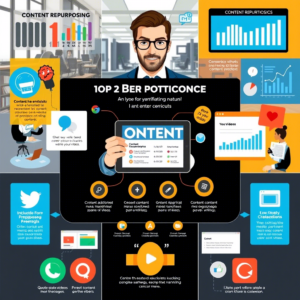In today’s digital landscape, capturing and maintaining audience attention is more challenging than ever. People are bombarded with information, making it crucial for brands to differentiate themselves. One of the most effective ways to engage your audience is through storytelling.
Storytelling in content marketing goes beyond selling a product or service; it creates an emotional connection that resonates with the audience. This article will explore how storytelling enhances content marketing, why it matters, and how you can implement it to build stronger relationships with your audience.
1. The Power of Storytelling in Marketing
Storytelling has been an essential part of human communication for centuries. It taps into emotions, making messages more memorable and impactful. In content marketing, storytelling can:
- Build trust and credibility
- Increase brand awareness and loyalty
- Improve audience engagement
Studies show that people remember stories 22 times more than facts alone. By crafting compelling narratives, brands can make their messages stick and create meaningful interactions with their audience.
Example: Nike’s Inspirational Stories
Nike doesn’t just sell shoes; they sell aspirations. Their marketing campaigns often feature real-life stories of perseverance and achievement, making their brand synonymous with motivation and success.
2. Understanding Your Audience’s Needs and Emotions
To create a compelling story, you must first understand your audience. What challenges do they face? What aspirations do they have? By addressing these aspects, you can craft stories that resonate with them on a deeper level.
How to Identify Your Audience’s Pain Points
- Conduct surveys and interviews
- Analyze social media discussions and feedback
- Review customer testimonials and reviews
Once you identify what matters most to your audience, tailor your storytelling to offer solutions, inspiration, or relatability.
Example: Dove’s Real Beauty Campaign
Dove tapped into a cultural conversation about self-image and confidence by sharing stories of real women rather than using models. This emotional approach strengthened customer loyalty and brand authenticity.
3. Crafting a Compelling Narrative
A well-structured story consists of three essential elements:
- A Relatable Character – Your audience should see themselves in the story.
- A Conflict or Challenge – The tension keeps the audience engaged.
- A Resolution – Provides inspiration or a solution that aligns with your brand.
The Hero’s Journey in Marketing
Many successful marketing campaigns follow the “hero’s journey,” where the protagonist (customer) faces a challenge and overcomes it with the help of a guide (your brand).
Example: Airbnb’s “Belong Anywhere” Storytelling
Instead of focusing on rentals, Airbnb showcases personal travel stories that highlight belonging and unique experiences, making customers feel emotionally connected to their brand.
4. Using Different Formats for Storytelling
Storytelling is not limited to blog posts. To maximize engagement, leverage various content formats, including:
- Videos: Short films, testimonials, and behind-the-scenes content
- Social Media Posts: Instagram stories, LinkedIn narratives, and Twitter threads
- Podcasts: Interviews, brand storytelling, and customer experiences
- Infographics: Visually appealing data-driven stories
- Case Studies: Real-world success stories that showcase your brand’s impact
Example: Coca-Cola’s “Share a Coke” Campaign
By personalizing their bottles with names, Coca-Cola encouraged customers to share their experiences on social media, turning their audience into brand storytellers.
5. Making Storytelling Authentic and Relatable
Consumers value authenticity. Forced or exaggerated storytelling can backfire, so it’s essential to remain genuine.
Tips for Authentic Storytelling:
- Use real customer experiences and testimonials
- Show behind-the-scenes content of your brand
- Be transparent about challenges and successes
Example: Patagonia’s Commitment to Sustainability
Patagonia doesn’t just claim to be eco-friendly—they tell authentic stories about their environmental initiatives and their impact, making their brand more trustworthy and relatable.
Conclusion
Storytelling in content marketing is more than just a trend; it’s a powerful strategy that fosters deeper connections with your audience. By understanding their emotions, crafting compelling narratives, leveraging different formats, and ensuring authenticity, you can create content that resonates and drives engagement.
Now, it’s your turn. How can you incorporate storytelling into your brand’s content strategy? Start today and build a lasting connection with your audience.




